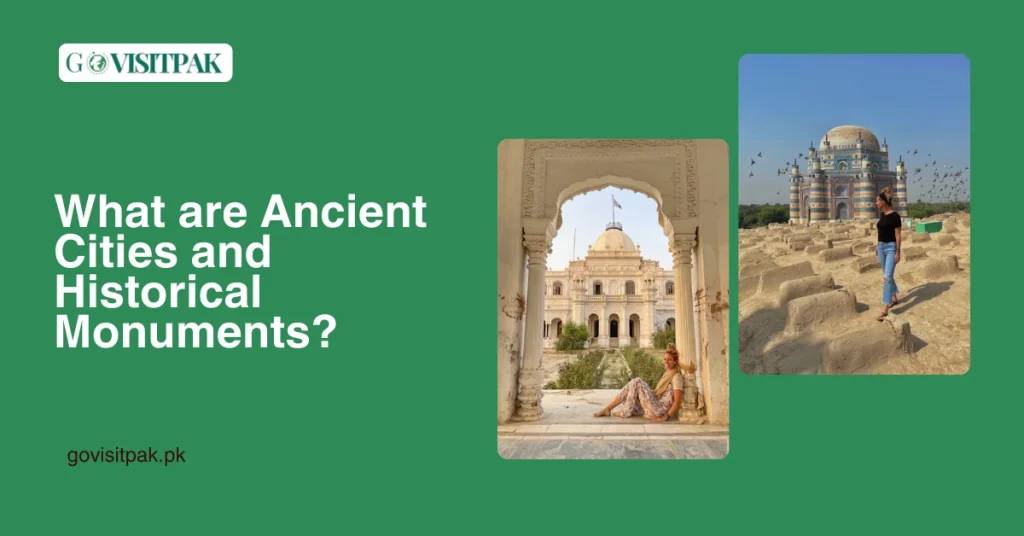In this article, you will discover about Historical sites of Pakistan. Pakistan has a vibrant history, pluralistic cultures, and awe-inspiring architecture. From old cities to majestic Mughal forts, there is history behind each corner of Pakistan. These places of history showcase the traditions, faiths, and civilizations that have evolved in the country over thousands of years.
In this article, we shall discuss the best historical sites in Pakistan that every history enthusiast should visit.
Pakistan has been inhabited by numerous civilizations, such as the Indus Valley Civilization, Gandhara Civilization, and Mughal Empire. The nation’s landscape is scattered with ancient ruins, beautiful mosques, powerful forts and royal palaces that speak volumes about previous rulers and societies.
From one of the world’s oldest cities, Mohenjo-Daro, to a masterpiece of Mughal architecture, Badshahi Mosque.
These sites retain the country’s rich historical roots. They reflect the artistic, cultural, and architectural excellence of the past. Each monument has a distinct tale of innovation, craftsmanship, and perseverance.
Most of the historical sites are under the threat of natural deterioration, urbanization, and abandonment. There is little to be done except to raise awareness, increase responsible tourism, and fund restoration efforts.
By conserving these jewels, Pakistan can safeguard its identity and give future generations a chance to enjoy the heritage left behind by ancient civilizations and mighty empires.
Let us start our tour of Pakistan’s most significant historical attractions.
What are Ancient Cities and Historical Monuments?

Ancient cities and monuments are windows to the past. They inform us about how people lived, what they constructed, and what they believed in. These sites are full of stories about kings, merchants, and common people.
Some cities were knowledge centers, whereas others were important centers for trade. Monuments, such as temples and palaces, reflect the art and culture of bygone times. They make us realize history and help us save our heritage.
Mohenjo-Daro: The Lost Civilization
Mohenjo-Daro, which means “Mound of the Dead”, is one of the world’s oldest planned cities. It was constructed around 2500 BCE as part of the Indus Valley Civilization.The city was well-planned with straight roads, brick buildings, and a sophisticated drainage system, testifying to the intelligence of the builders. The Great Bath, a large tank for water, indicates that water was either of religious or social significance.
Archaeologists have unearthed pottery, jewelry, and tools, providing information about everyday life. The writing system of the city is still undeciphered, making it even more mysterious. Its abrupt fall is not known, but floods or invasions could have been responsible. Mohenjo-Daro is now a UNESCO World Heritage Site, reminding us of a lost but advanced civilization.
Main Features of Mohenjo-Daro:
- Sophisticated city planning with drains, brick houses, and broad roads.
- The Great Bath, a massive water tank for religious or social reasons.
- Granaries, where the food for the city’s inhabitants was stocked.
- The Dancing Girl Statue, a bronze statue that reflects the artistic abilities of the Indus civilization.
Mohenjo-Daro is currently a UNESCO World Heritage Site but is under danger from erosion and abandonment.
Taxila: The Ancient Center of Learning
Taxila, situated near Islamabad, was a celebrated Gandhara civilization town. It was the foremost hub of Buddhist scholarship and culture. Students from all over the globe visited in order to study medicine, astronomy, and philosophy at its universities.
The city was prosperous from the 6th century BCE through the 5th century CE as a prime centre for intellectual and commercial activity. It had one of the world’s first universities, in which scholars such as Chanakya and Panini made notable contributions to literature and administration. Remnants of monasteries, stupas, and classrooms are evidence of its rich academic and religious tradition.
Taxila is now a UNESCO World Heritage Site and is visited by historians, archaeologists, and travellers. Its preservation is important to comprehend the intellectual and cultural developments of ancient societies.
Places of Interest in Taxila:
- Dharmarajika Stupa is a Buddhist shrine constructed by Emperor Ashoka.
- Jaulian Monastery, a Buddhist university.
- Sirkap Ruins, a Greek city constructed following the invasion of Alexander the Great.
Taxila is another UNESCO World Heritage Site and a significant site of Pakistan’s Buddhist heritage.
Makli Necropolis: The City of Silence
Sindh is where Makli Necropolis is situated. It is one of the world’s largest cemeteries, spanning 10 square kilometres. It has the graves of kings, saints and scholars from various periods. This extensive necropolis, which stretches as far back as the 14th century, depicts the architectural and cultural development of Sindh. The graves contain carvings, tile work in the style of Persia and Mughals, and calligraphy in minute details. The graves of many Samma, Arghun, Tarkhan, and Mughal rulers are present there.
A UNESCO World Heritage Site, Makli Necropolis is a silent but forceful witness to history. It draws tourists, historians, and spiritual travelers who are impressed by its artistic elegance and historical value.
Makli Necropolis highlights:
- Well-carved stone tombs with Islamic calligraphy.
- Tomb of Jam Nizamuddin, a magnificent structure constructed with sandstone.
- Persian and Mughal-style adornments on numerous tombs.
Makli Necropolis is a UNESCO World Heritage Site and a must-see for history buffs.
What are Magnificent Mosques and Islamic Architecture?
Beautiful mosques and Islamic buildings demonstrate the charm, culture, and religious spirit of Islamic civilization. They have large domes, tall minarets, and ornate geometric designs. Calligraphic inscriptions, floral motifs, and symmetrical compositions make them a joy to the eyes.
Islamic architecture is not only concerned with aesthetics—it is also concerned with functionality, with open courtyards, prayer rooms, and mihrabs facing Mecca. From the Great Mosque of Córdoba to Istanbul’s grand mosques, each of them has a story of religious devotion, historical significance, and artistic perfection.
Badshahi Mosque: The Crown of Lahore
The Badshahi Mosque, constructed in 1673 by Emperor Aurangzeb, is one of the world’s largest mosques.It is a testament to Mughal splendor, with its enormous red sandstone walls and exquisitely ornamented domes. The courtyard of the mosque, which is among the largest in the world, can hold more than 55,000 people at a time. The four minarets that rise high above the ground provide a panoramic view of Lahore, enhancing its grandeur.
Within, the prayer chamber is adorned with delicate floral patterns, marble inlays, and exquisite Quranic calligraphy, instilling an ambience of religious serenity. The mosque has been the center of many historical events ranging from royal ceremonies to political affairs. It is still a cherished landmark of Pakistan, attracting visitors from everywhere on earth.
Why Visit the Badshahi Mosque?
- Red sandstone walls and intricate marble decorations.
- Capacity for 100,000 people to pray.
- Grand entrance and minarets provide a stunning view of Lahore.
The Badshahi Mosque is still a symbol of Mughal grandeur and is among Pakistan’s most popular tourist spots.
Faisal Mosque: The Modern Marvel
The Faisal Mosque in Islamabad is Pakistan’s largest mosque. It was constructed in 1986 through a grant by Saudi King Faisal.In contrast to common domed mosques, Faisal Mosque boasts an unusual, tent-like architecture reflecting the design of Bedouin tents. It features four prominent minarets and a triangular shape that provide a dramatic look against the view of the Margalla Hills.
The prayer hall of the mosque is large, with a capacity for more than 100,000 people. The walls inside have plain yet beautiful Islamic calligraphy. The mosque is not just a place of worship but also a tourist destination. It is serene and its beauty is stunning, making it one of the most visited places in Pakistan.
Distinctive Aspects of Faisal Mosque:
- Contemporary Islamic architecture free from the classical domes.
- Gigantic white marble complex with four high minarets.
- Capable of seating more than 100,000 individuals.
Surrounded by the Margalla Hills, Faisal Mosque provides a serene and devotional experience.
Shah Jahan Mosque: A Sindh Masterpiece
Situated in Thatta, Sindh, this mosque was constructed by Emperor Shah Jahan in 1647. It is renowned for its beautiful tile work and elaborate geometric designs. Unlike most Mughal mosques, it lacks minarets but boasts 93 exquisitely designed domes. The distinctive dome layout improves acoustics, with the imam’s voice ringing out clearly across the mosque without the use of modern speakers.
The walls of the mosque are adorned with white and blue Persian-style tiles that give it a serene and aesthetic environment. It is one of Pakistan’s most well-preserved historical monuments that draws tourists for its beauty as well as exceptional acoustic design.
Why is it Special?
- Breathtaking blue-tiled domes and walls.
- No iron or wood is used in construction.
- Special echo system that enables the Imam’s voice to reach every worshiper.
The Shah Jahan Mosque is one of the world’s most gorgeous examples of Mughal architecture.
What are historical Palaces and Royal Residences?
Historical palaces and royal palaces are magnificent buildings constructed for the kings, queens, and monarchs. These were not only dwelling places but indicators of power, richness, and culture. Most palaces have luxurious halls, stunning gardens, and intricate art work.
They used to have significant events, royal gatherings, and functions. Some, such as the Alhambra in Spain or the royal complex of the Taj Mahal, remain today as a testament to former empires. Nowadays, most of these palaces are turned into museums where people can have a glimpse into the rich heritage and architectural masterpieces of earlier civilizations.
Noor Mahal: The Palace of Lights
The Noor Mahal, built in Bahawalpur in 1872, is an Italian-style palace used by the Nawabs. The palace served as a place for royal events and state sessions. Its intricately decorated halls and artistic ceilings speak of the sophistication of the Nawab period.
Surrounded by gardens, Noor Mahal shines resplendently at night, living up to its name as the “Palace of Lights.” Now, it is a restored heritage site, open to the public to marvel at its historical grandeur and learn about Bahawalpur’s royal heritage.
- Key Attractions: European-style architecture with chandeliers and marble floors.
- Beautiful gardens and fountains.
- Royal furniture and rare paintings inside.
Mohatta Palace: Karachi’s Cultural Gem
The Mohatta Palace, built in 1927, is a Rajasthani-style mansion in Karachi. It was built by Shivratan Chandraratan Mohatta, a businessman who was affluent, as a summer residence. The palace is marked by ornate domes, carved windows, and Jodhpur pink stone, lending it a unique appearance.
Originally a private residence, the palace later became a government building and is now a museum showcasing Pakistan’s rich cultural heritage. It hosts art exhibitions, historical artifacts, and cultural events. Surrounded by lush gardens, Mohatta Palace stands as a symbol of Karachi’s architectural beauty and continues to attract visitors who admire its history and artistic charm.
Why Visit Mohatta Palace?
- Pink stone exterior from Rajasthan.
- Secret underground tunnels.
- Now a museum showcasing Pakistani art and history.
What are Historic Forts and Defense Structures?
Historical defense sites and forts were constructed to safeguard cities, monarchs, and significant trade routes. These powerful forts were constructed with fortified walls, guard towers, and secret corridors to resist invading forces. Most forts were also palaces of kings and administrative buildings. Eventually, they became symbols of power and architectural prowess.
From the Great Wall of China to the European castles, these forts are the keepers of stories of battles, kings, and empires. Now, many forts are well-preserved as heritage sites, giving a glimpse into the military and cultural history of ancient civilizations.
Lahore Fort: A Mughal Masterpiece
The Lahore Fort, constructed by the Mughals, is a UNESCO World Heritage Site. This magnificent fortress, or Shahi Qila, is a testament to the architectural excellence of the Mughal period.
It was originally constructed in ancient times but was later extended by Emperor Akbar in the 16th century and altered by later rulers. The fort has huge gates, exquisitely ornamented halls, and delicate tile work that is a combination of Persian and Mughal styles.
One of its most renowned parts is the Sheesh Mahal (Palace of Mirrors), which is covered with thousands of small pieces of mirrors that give a blinding effect when light falls on them.
The fort also contains the Naulakha Pavilion and the magnificent Alamgiri Gate, constructed by Emperor Aurangzeb. For centuries, Lahore Fort has seen royal rituals, military activities, and historical transitions. Now, it is a proud relic of Pakistan’s glorious past, visited by tourists and history enthusiasts from across the globe.
- Main Attractions: Sheesh Mahal (Palace of Mirrors).
- Naulakha Pavilion, featuring its roof covered in gold.
- Massive gates and grand courtyards.
Rohtas Fort: A Stronghold of Power
Rohtas Fort was constructed by Sher Shah Suri in the 16th century. Commissioned to protect his empire and keep out the Mughal emperor, Humayun, from returning, this huge fort is a work of genius when it comes to military architecture. Situated on the outskirts of Jhelum, in Pakistan, the fort spans approximately 70 hectares.
The walls of the fort are more than 4 kilometres long, with 12 large gates and powerful bastions to resist attacks. Some of its most renowned buildings include the Sohail Gate, Talaqi Gate, and Haveli Man Singh. Rohtas Fort is different from other Mughal forts in that it combines Afghan and Indian architectural influences.
A UNESCO World Heritage Site, Rohtas Fort stands as a testament to fortitude and resilience. Travellers and historians flock to this towering fortress to discover its glorious history and marvel at its defensive architecture.
Why is it Important?
- Thick walls and heavy gates made for defence.
- The Man Singh Haveli, a palace within the fort.
- A fine example of Afghan and Mughal war architecture.
What are Cultural Heritage and Religious Sites?
Cultural sites and religious places are locations that are of historical, spiritual, and cultural interest. They are ancient temples, mosques, churches, and shrines that represent the faith and traditions of various civilizations.
They tend to draw pilgrims, historians, and tourists who are interested in a connection with history and religion. These places have beautiful architecture, elaborate carvings, and sacred icons that narrate tales of piety and cultural transformation.
The following are some examples of cultural and religious sites:
Conservation of such sites ensures that traditions are maintained and future generations can learn about the rich heritage of various communities.
Katas Raj Temples: A Sacred Hindu Site
The Katas Raj Temples in Punjab are more than 2,000 years old.The place is renowned for the holy Katas pond, which is said to have been created by the tears of Lord Shiva following the death of his wife, Sati. The water is considered holy by Hindus and they conduct rituals here.
The site comprises a number of exquisitely sculpted temples with traditional Hindu design, intricate stone carvings, and staircases. Throughout the centuries, Katas Raj has been a hub for spiritual congregations and religious celebrations. The site is also associated with myths, such as tales about the Pandavas of the Mahabharata.
Today, the Katas Raj Temples are maintained as a religious and historical heritage site. Pilgrims and tourists come to marvel at its ageless beauty and enjoy its serene environment. The temple complex is a testament to Pakistan’s rich cultural and religious past.
Why are they special?
- Built around a holy pond, believed to have healing powers.
- Dedicated to Lord Shiva.
- A mix of Hindu and Buddhist architecture.
Hiran Minar: Jahangir’s Tribute to His Pet
The Hiran Minar in Sheikhupura was built by Emperor Jahangir in memory of his pet deer, Mansraj. Built in the early 17th century, this special monument is a representation of the love of nature and animals by the Mughals. The compound includes a towering minaret, a huge tank of water, and a picturesque pavilion, providing a tranquil oasis for the royal family.
The 100-foot-tall minaret rises high with minute openings, perhaps for hunting or observation. The surrounding water tank, with a central baradari (pavilion), contributes to its elegance. The minar and the surrounding area were planned as a royal hunting ground and a resting spot.
Today, Hiran Minar is a popular tourist destination, attracting visitors who admire its architectural elegance and serene atmosphere. The site stands as a unique example of Mughal-era monuments built for love and remembrance.
What’s Unique?
- A tall minaret and a big water tank.
- A quiet picnic area with history all around.
Saving Pakistan’s History
Pakistan’s historical monuments are an asset that has to be preserved and protected. These monuments speak about the stories of ancient civilizations, great empires, and multitudinous cultures. Ranging from majestic Mughal forts to sacred religious monuments, all the structures carry immense historical and architectural value. But they face threats to their survival due to time, climate, and disregard.
Efforts have to be made to preserve and conserve these gems through conservation efforts, proper tourism, and state funding. Creating awareness about their significance can also serve to motivate individuals to conserve them. With conservation of Pakistan’s rich heritage, future generations can still learn and admire the country’s outstanding heritage.
How Can We Preserve These Places?
- Encouraging tourism so that people are aware of these places.
- Government actions to restore old buildings.
- School programs for new generations.
By respecting and preserving our heritage, we can make sure that these ancient sites continue to inspire and educate generations to come.
Conclusion
Pakistan boasts some of the most incredible historical sites in the world. From ancient cities such as Mohenjo-Daro and Taxila to splendid Mughal architecture and magnificent forts, Every site has a story to tell.
These places tie us to our heritage, assist us in learning about other cultures, and remind us of the glorious past of our country.
So, if you are history enthusiast, begin discovering Pakistan’s incredible historical sites today!
FAQs:
Which is the best historical sites in Pakistan?
The Badshahi Mosque Lahore is perhaps the most well-known historical monument. It is a breathtaking display of Mughal architecture and welcomes tourists from all across the globe.
What is the oldest historical site in Pakistan?
Mohenjo-Daro, constructed circa 2500 BCE is the oldest historical site in Pakistan. It was part of the Indus Valley Civilization and is among the world’s earliest planned cities.
How many UNESCO World Heritage Sites are located in Pakistan?
Pakistan has six UNESCO World Heritage Sites, including Mohenjo-Daro, Taxila, Lahore Fort, Rohtas Fort, Makli Necropolis, and the Buddhist Ruins of Takht-i-Bahi.
Which is the most beautiful fort in Pakistan?
The Lahore Fort is one of the most beautiful forts in Pakistan. It boasts stunning buildings like Sheesh Mahal (Palace of Mirrors) and Naulakha Pavilion.
Why is Taxila significant?
Taxila was a century-old centre of Buddhist scholarship and the most prominent component of the Gandhara culture. Taxila was affected by Greek, Persian, and Indian influences.
Are tourists allowed in historical sites of Pakistan?
Yes, the majority of Pakistan’s historical sites are open for tourists. Certain places will need to obtain permission, though, or perhaps have scheduled hours.
What is the most popular palace in Pakistan?
Noor Mahal in Bahawalpur is arguably the most popular palace. It features an impressive European-style architecture and was constructed for the Nawab royal family.
Are Hindu temples found in Pakistan?
Yes, there are a few historic Hindu temples in Pakistan, including the Katas Raj Temples and Shri Hinglaj Mata Temple in Balochistan.
Which are the top historical spots suitable for a visit by families?
Lahore Fort, Badshahi Mosque, Hiran Minar, Faisal Mosque, and Mohatta Palace are spots which can be visited by families. These spots are gorgeous, informative, and enjoyable for both adults and kids.
Why are historical places of Pakistan important to preserve?
Historical sites are part of our cultural heritage. They educate us regarding the past, promote tourism, and inform future generations about history. Their preservation guarantees that they continue to be a point of pride and knowledge.





